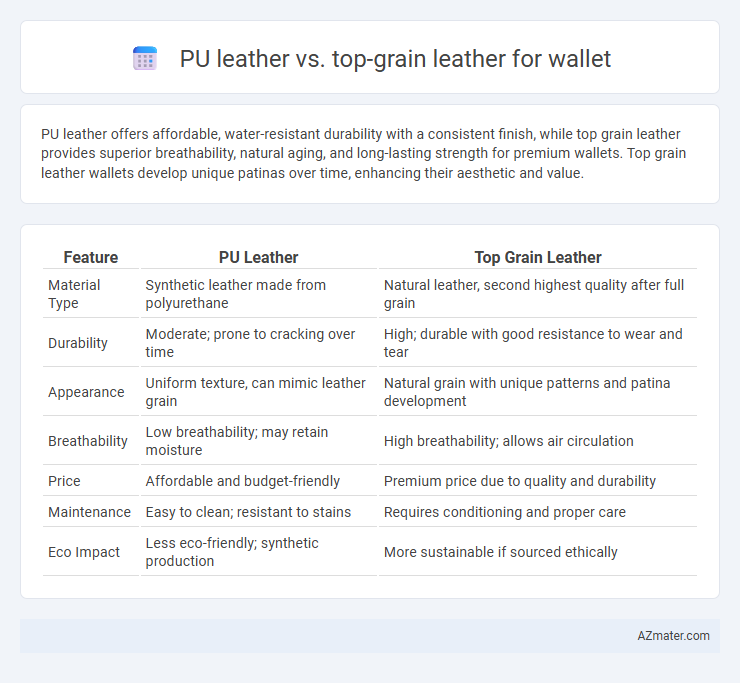PU leather offers affordable, water-resistant durability with a consistent finish, while top grain leather provides superior breathability, natural aging, and long-lasting strength for premium wallets. Top grain leather wallets develop unique patinas over time, enhancing their aesthetic and value.
Table of Comparison
| Feature | PU Leather | Top Grain Leather |
|---|---|---|
| Material Type | Synthetic leather made from polyurethane | Natural leather, second highest quality after full grain |
| Durability | Moderate; prone to cracking over time | High; durable with good resistance to wear and tear |
| Appearance | Uniform texture, can mimic leather grain | Natural grain with unique patterns and patina development |
| Breathability | Low breathability; may retain moisture | High breathability; allows air circulation |
| Price | Affordable and budget-friendly | Premium price due to quality and durability |
| Maintenance | Easy to clean; resistant to stains | Requires conditioning and proper care |
| Eco Impact | Less eco-friendly; synthetic production | More sustainable if sourced ethically |
Introduction to PU Leather and Top Grain Leather
PU leather, a synthetic material made from polyurethane applied to a fabric backing, replicates the look and feel of genuine leather while being more affordable and resistant to water and scratches. Top grain leather, derived from the top layer of cowhide, undergoes sanding and buffing to remove imperfections, providing a smooth, durable surface with natural breathability and aging characteristics. For wallets, PU leather offers budget-friendly style and easy maintenance, while top grain leather delivers superior strength, longevity, and a premium texture valued in high-quality accessories.
Key Differences Between PU Leather and Top Grain Leather
PU leather is a synthetic material made from polyurethane coating on fabric, offering affordability, water resistance, and easy maintenance, while top grain leather is a natural cowhide leather known for its durability, breathability, and luxurious texture. Top grain leather undergoes surface sanding to remove imperfections, resulting in a smooth finish and natural grain patterns, whereas PU leather mimics this appearance but lacks the unique texture and aging qualities of genuine leather. In wallets, top grain leather develops a rich patina over time, enhancing character, whereas PU leather maintains a consistent look but may crack or peel with prolonged use.
Durability Comparison: PU Leather vs Top Grain Leather Wallets
Top grain leather wallets offer superior durability compared to PU leather due to their natural toughness and resistance to wear and tear. PU leather, being synthetic, tends to crack and peel over time, especially with frequent use and exposure to moisture. While PU leather wallets are more affordable and water-resistant, top grain leather wallets provide long-lasting strength and develop a unique patina that enhances their durability and aesthetic appeal.
Appearance and Texture: Which Looks and Feels Better?
Top grain leather boasts a natural grain pattern and soft, supple texture that improves with age, giving wallets a premium, authentic look and feel. PU leather mimics real leather's appearance but often lacks the depth and breathability, feeling smoother and less textured, which can come across as artificial. For wallets, top grain leather offers superior tactile comfort and a more luxurious, visually appealing finish compared to PU leather.
Cost Analysis: Affordable Choices for Every Budget
PU leather wallets generally offer a more affordable option, with prices often ranging from $10 to $50, making them ideal for budget-conscious consumers. Top grain leather wallets, priced typically between $50 and $200, provide higher durability and a premium feel but come at a higher cost. Evaluating long-term value, PU leather wallets require more frequent replacement, whereas top grain leather wallets often prove cost-effective due to their longevity and classic aging properties.
Environmental Impact: Sustainability of PU vs Top Grain Leather
PU leather offers a more sustainable alternative to top grain leather by using synthetic materials that avoid animal farming and reduce natural resource consumption. Top grain leather production involves intensive water usage, chemical tanning, and deforestation, contributing significantly to environmental degradation. However, PU leather's reliance on plastics can pose long-term pollution challenges, making eco-friendly disposal and recycling critical considerations in evaluating overall sustainability.
Maintenance & Care Requirements
PU leather wallets require minimal maintenance, easily cleaned with a damp cloth and mild soap, making them resistant to stains and water damage. Top grain leather wallets demand regular care, including conditioning every 3-6 months to prevent drying and cracking while avoiding prolonged exposure to moisture and direct sunlight. Proper maintenance of top grain leather ensures durability and maintains its natural texture, whereas PU leather prioritizes convenience and low upkeep.
Water Resistance and Everyday Practicality
PU leather offers superior water resistance compared to top grain leather, making it a practical choice for wallets exposed to moisture during daily use. Top grain leather, while more breathable and durable, requires regular conditioning to maintain its water-repellent properties and avoid staining. For everyday practicality, PU leather provides easier maintenance and better protection against water damage, while top grain leather delivers a higher-end aesthetic with natural aging characteristics.
Longevity: How Each Material Ages Over Time
PU leather offers moderate longevity, often showing visible wear, peeling, and cracking within a few years due to its synthetic nature and lower durability. Top grain leather ages gracefully, developing a rich patina and becoming softer while maintaining structural integrity over decades with proper care. The inherent natural fibers of top grain leather provide superior resistance to daily wear and tear compared to the more delicate surface of PU leather.
Which Leather is Best for Wallets? Final Recommendations
Top grain leather offers superior durability, natural texture, and breathability, making it the best choice for high-quality wallets that age gracefully over time. PU leather, a synthetic alternative, provides water resistance and lower cost but lacks the longevity and premium feel of genuine leather. For wallets intended as long-term investments or luxury accessories, top grain leather is the recommended material.

Infographic: PU leather vs Top grain leather for Wallet
 azmater.com
azmater.com